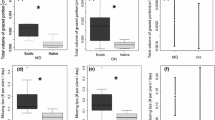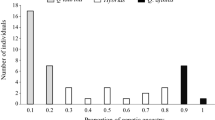Abstract
To test hypotheses of herbivore response to hybrid plants, I determined the preference of the generalist beetle Lochmeae capreae for individuals of Salix caprea, Salix phylicifolia and F1 hybrids between these species. F1 hybrids and pure individuals were created by hand-pollination of willow individuals in the field. The preference tests were performed in 1994 and 1995 and in both years there was a tendency for higher leaf area consumption from hybrids than from the parental species. However, statistically significant differences in consumption were only found in 1995 between hybrids and S. phylicifolia. The result from this study therefore lends most support to the dominance hypothesis: hybrid susceptibility was similar to that of one of the parental species. This is one of the first strict preference tests showing that a generalist herbivore can detect differences in palatability between hybrids and parental species. Furthermore, the experimental design used in the study minimized environmental variation. The results should therefore primarily reflect genetically based quality differences between hybrids and parental species.
Similar content being viewed by others
Author information
Authors and Affiliations
Additional information
Received: 4 March 1996 / Accepted: 12 August 1996
Rights and permissions
About this article
Cite this article
Hjältén, J. Willow hybrids and herbivory: a test of hypotheses of phytophage response to hybrid plants using the generalist leaf-feeder Lochmaea caprea (Chrysomelidae). Oecologia 109, 571–574 (1997). https://doi.org/10.1007/s004420050118
Issue Date:
DOI: https://doi.org/10.1007/s004420050118




